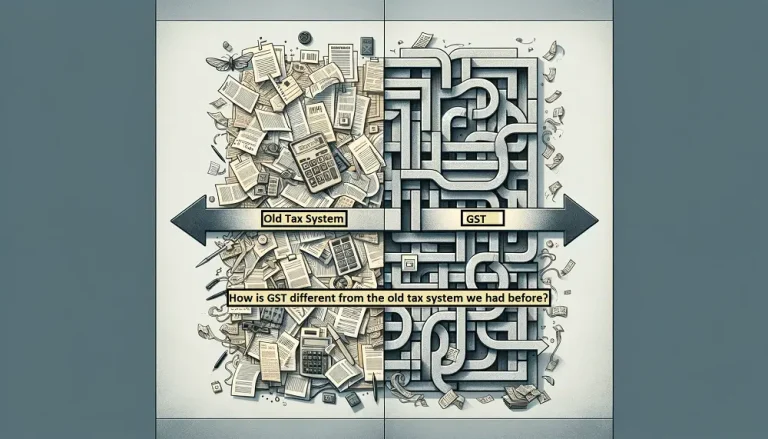Switching from the old tax system to the Goods and Services Tax (GST) in India was a big deal. It changed how we handle taxes. This blog will break down the basic differences between the old way of taxing things and the new GST system. We want to make sense of these changes and see how they affect businesses and regular folks. So, let’s get into it and understand why GST has become such a game-changer in how we deal with taxes in India.
Old Tax System
The old tax system worked by taking a part of what people and businesses earned as taxes. For individuals, this meant sharing details about their income, like how much they earned and spent, while businesses reported their profits and expenses. However, there were problems. Figuring out how much to pay was confusing. People found it hard to understand the rules, and sometimes mistakes were made. Another issue was that some rich folks could find ways to pay less tax, making things seem unfair.
The old tax system was a bit complicated, making it tough for regular folks to get it right. It also seemed like some rich people had an easier time paying fewer taxes. That’s why there were talks about making a better, fairer tax system.
GST Implementation
Goods and Services Tax (GST) was introduced in India on July 1, 2017. The main reason behind this change was to make taxes simpler. Before GST, there were many different taxes, and it was a bit confusing. GST replaced these with one tax for both goods and services. The goal was to make things easier for businesses and stop people from avoiding taxes. With GST, there’s just one tax rate for goods and services. This helps goods move smoothly from one place to another without any extra taxes piling up. To make all these changes, the central and state governments worked together. They formed a group called the GST Council. This group decided on the tax rates and other important things about GST. Businesses also had to update their systems to follow the new rules.
In short, GST in 2017 made taxes simpler by combining different taxes into one. This helped businesses and made the movement of goods and services smoother across the country.
Goods and Services Tax (GST) Basics
Let’s break down how GST works in simple terms:
What is GST: GST is like a one-stop-shop tax for goods and services. Instead of having many different taxes, GST bundles them up into one, making things less complicated.
Tax at Each Step: Imagine you’re baking a cake. You buy the ingredients (flour, sugar, etc.), mix them, and bake the cake. Now, at each step, GST is like a small tax added to the value you’re creating.
No Double Tax: The cool thing about GST is that it doesn’t tax the tax. Let’s say you buy flour and pay a little GST. When you sell the cake, you don’t pay GST on the whole price again, just on the extra value you added by baking.
Credit for Businesses: Businesses can also get a kind of discount called “Input Tax Credit.” This means if they paid GST when buying stuff, they can subtract that from the GST they collect when selling things.
Example:
Think of a pizza. The dough costs $5, and the pizza place adds $3 worth of toppings. The total is $8. If GST is 10%, they pay $0.80 (10% of $8) in tax. When you buy the pizza, you pay this tax. But the pizza place already got credit for the $0.80 they paid when buying the dough and toppings, so it’s fair.
GST is like a friendlier way of taxing things. It keeps things simple, avoids taxing the same thing twice, and lets businesses get credit for the taxes they’ve already paid.
Also read – Which Forms Do Need to Fill Out for GST Returns?
GST Advantages
GST, or Goods and Services Tax, offers several benefits that significantly impact businesses and the overall taxation system.
- Easy Taxes: GST makes taxes simpler. Instead of dealing with many different taxes, now there’s just one tax to understand and follow.
- No More Double Taxes: Before GST, businesses had to pay taxes on top of taxes, which made things more expensive. With GST, this extra tax burden has been reduced, making things more straightforward.
- Simple Rules: GST has easy rules. Businesses can quickly understand and follow them. It means less paperwork and more time for running the business.
- Get Credit for Taxes Paid: Businesses can now get credit for the taxes they pay on their inputs. This helps in being fair and transparent, as they can subtract what they paid for inputs from what they collected in taxes.
- Same Rules Everywhere: In the past, different states had different tax rules, making trade between states confusing. Now, with GST, rules are the same everywhere, making it easier for goods and services to move across the country.
- Helps the Economy: Because GST makes things simpler for businesses, it also helps the country’s economy to grow. It makes our goods and services more competitive around the world.
Key Differences between the Old Tax System and GST:
Here are some key differences between the old tax system and gst:
Tax Structure:
- Old Tax System: Had many different taxes like excise duty and service tax, making it complicated.
- GST: Uses one single tax, making things simpler and bringing everything under one roof.
Tax Calculation:
- Old Tax System: Tax was calculated at every step of making and selling things, causing prices to go up.
- GST: Taxes are only added on the value that’s added at each step, avoiding extra costs and keeping things more affordable.
Input Tax Credit:
- Old Tax System: Businesses couldn’t get much credit for the taxes they paid on things, leading to higher costs.
- GST: Lets businesses get credit for the taxes they paid on what they bought, reducing their overall tax bill.
Compliance Burden:
- Old Tax System: Businesses had to do a lot of paperwork and follow many rules, making things hard.
- GST: Makes it easier with one online system for filing taxes, reducing the paperwork and making things simpler for businesses.
Tax Transparency:
- Old Tax System: People didn’t really know how much tax was in the prices of things they bought.
- GST: Shows the tax clearly in the price, so people know what they are paying for.
Threshold Exemption:
- Old Tax System: Small businesses had to follow the same rules as big ones, making it tough for them.
- GST: Small businesses don’t have to pay GST if they earn below a certain limit, making it easier for them.
Taxation on Services:
- Old Tax System: Services had their own separate tax rules.
- GST: Treats goods and services the same way, making the rules the same for both.
Economic Impact:
- Old Tax System: Could make things inefficient and not fair because of extra costs and complicated rules.
- GST: Tries to make things work better and be more competitive by getting rid of extra costs and making rules simpler.
These differences show the move from a complicated and scattered tax system to a simpler and more straightforward GST system, aiming for simplicity, fairness, and less hassle for businesses and people alike.
Impact on Consumers
Let’s talk about how GST impact on regular people in simple terms.
- Cost of Living: Our overall cost of living might go up or down because of GST. Some things we buy might get cheaper, and others might get more expensive. So, it can affect how much money we need for everyday life.
- Good and Bad Effects: Some things might become cheaper, like food and basic stuff we need every day. But some fancier things or services could become more expensive.
- Easier Taxes: GST makes taxes simpler. Instead of many different taxes, we have one tax for everything. It’s like trying to understand one big idea instead of many small ones.
- Money for Government and Services: The government gets money from GST, and they can use it for things like fixing roads or providing services. But if not managed well, it could also make businesses spend more money, which might affect jobs and the country’s money situation.
Implications for Businesses
The Goods and Services Tax (GST) has brought good changes for businesses. First off, things are less complicated now. Transportation has also gotten better. In the past, moving goods between states was a hassle with lots of stops and checks. GST has made it easier to transport things, reducing costs and making it faster to get products where they need to go.
Doing business has become easier too. With GST, businesses don’t have to deal with different tax rules in each state. This makes it simpler to start a business and expand it to different places. GST has made things less complicated, improved how goods are moved, and made it easier to run a business. It’s like a helping hand for businesses to grow and do better.
Conclusion
India changed how it handles taxes by introducing Goods and Services Tax (GST) in 2017. The old system was complicated, not clear, and some could find ways to avoid paying taxes. GST came to make taxes simpler, stop double taxation, and create a fair and clear system for everyone. It’s like upgrading from a confusing way of doing things to a much better and understandable way.
Frequently Asked Questions
What is GST?
GST, or Goods and Services Tax, is a comprehensive indirect tax levied on the supply of goods and services in India. It replaced multiple indirect taxes like VAT, excise duty, and service tax, streamlining the taxation system.
How does GST work?
GST operates on the principle of value addition at each stage of the supply chain. It is levied at every point of sale, with credit allowed for any tax paid on procurement of inputs, ensuring that the final consumer bears the tax burden.
What are the benefits of GST?
GST brings various advantages such as simplifying the taxation structure, reducing tax evasion, eliminating cascading effects, promoting ease of doing business, and fostering a common national market.
How is GST different from the old tax system?
Unlike the previous fragmented tax regime, GST integrates taxes across the supply chain, enabling seamless tax credits, eliminating double taxation, and creating a unified national market.
Who is liable to pay GST?
GST is applicable to businesses engaged in the supply of goods or services, whose aggregate turnover exceeds the threshold limit prescribed by the government, varying for different states.
What are the GST rates?
GST rates are categorized into four main slabs: 5%, 12%, 18%, and 28%, based on the type of goods or services. Some goods and services are exempted or taxed at a nil rate.
Are there any exemptions under GST?
Yes, certain goods and services such as essential food items, healthcare, education, and specific agricultural products are exempted from GST to ensure affordability and accessibility.
How does GST impact consumers?
GST aims to benefit consumers by making goods and services more affordable through the elimination of cascading taxes and reducing the overall tax burden on end products.
How does GST affect businesses?
GST simplifies compliance procedures, enhances tax transparency, promotes better inventory management, reduces logistics costs, and fosters a competitive business environment.
How has GST transformed the Indian economy?
GST has led to increased tax compliance, expanded the tax base, boosted GDP growth, facilitated seamless interstate trade, and contributed to the formalization of the economy.





GST filling is very easy from MargBooks Software
great Informative blog thankyu